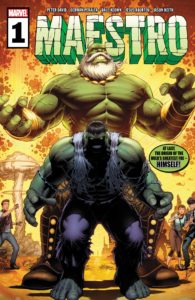
 Introduced in Peter David’s seminal run of The Incredible Hulk, Maestro is the villainous version of Bruce Banner from an alternate timeline, whose origin has long been alluded to but never depicted. That changes in this week’s Maestro #1, finally showing readers just how this universe’s Bruce broke so bad. Have all the years of mystery been worth it?
Introduced in Peter David’s seminal run of The Incredible Hulk, Maestro is the villainous version of Bruce Banner from an alternate timeline, whose origin has long been alluded to but never depicted. That changes in this week’s Maestro #1, finally showing readers just how this universe’s Bruce broke so bad. Have all the years of mystery been worth it?
I’ve only read some of David’s Incredible Hulk, which spanned 12 years of ongoing stories, but I’m familiar with Maestro through general osmosis by reading Marvel comics. I wasn’t aware that his origin story had never been directly told, however, so the idea of finally exploring Bruce Banner’s transformation into a supervillain is fairly novel. That being said, this first issue didn’t make an especially strong case to me that we need to see it.
Far-reaching franchises like the Marvel Universe always run the risk of explaining everything at a certain point, even if the answers given aren’t especially interesting (the revelation of Han Solo’s surname in Solo remains a watermark codifier of this phenomenon). For a character like Maestro, simply alluding to their past and leaving things mysterious is often the best way to deliver backstory. Part of their appeal is the not-knowing. That’s a mistake DC Comics has been making far too frequently with Joker ever since The Killing Joke, and it won’t seem to be stopping anytime soon, with Joaquin Phoenix’s Joker becoming the first R-Rated film to gross a billion dollars and Geoff Johns’s The Three Jokers already a top-seller before it’s even released. But that’s a whole other conversation to be had.
In reading Maestro, I just didn’t come away from it feeling like his backstory was a gap that needed filling. Whatever you might have guessed would’ve triggered Bruce’s ultimate transformation, you’re probably not far off from what’s shown here. I’m sure this is a story that David has wanted to tell since the original “Future Imperfect” storyline that Maestro debuted in, and it’s exceedingly competent in what it sets out to do, but is that enough to justify its existence in an oversaturated industry that’s currently suffering from the economic fallout of a global pandemic? I’m not sure. (To be fair, there’s no way David could have foreseen the world in which this comic would’ve been released, but the point stands.)
The art of Maestro #1 is at least very good, splitting the talents of Germán Peralta and Dale Keown in a double-hander. Most of the issue is drawn by Peralta, with a prologue of sorts by Keown, but I’m not sure if this was a scheduling matter or if there’s artistic intent in having their art juxtaposed against the other (see: DC’s current Strange Adventures). I would assume the former, which isn’t uncommon for monthly superhero books, but the clear separation between their sections suggests we’re meant to notice an aesthetic shift when it happens, and I don’t know if that comes across. I suppose Keown’s art is classically “superhero” in that it consists of realistic characters perfectly placed and posed in panels with clean layouts, while Peralta’s art is more dynamic and a tad bit stylized, but the overall package with coloring included (by Jason Keith and Jesus Aburtov, respectively) feels more cohesive and visually consistent than not. In any event, their art is strong if not especially notable, which more or less sums up how I felt about the issue as a whole.



![[REVIEW] AMERICA CHAVEZ: MADE IN THE USA #1](https://geekd-out.com/wp-content/uploads/2021/03/08DAFBE2-DB2D-40C7-B3E7-27F2DE10E4C1-150x150.jpeg)
One thought on “[REVIEW] MAESTRO #1”